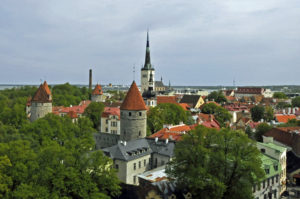
Old Town of Tallinn, Estonia, from Toompea (Photo by Don Knebel)
The city now known as Tallinn was founded on the southern shore of the Gulf of Finland sometime before 1154, when the town appeared on a Muslim cartographer’s map. After the town was captured by Denmark in 1219, it was named Reval. Strategically located between Russia and Scandinavia, Reval became an important medieval trading center. In 1285, it joined the Hanseatic League, a confederation of northern European market towns. Merchants built large homes in an area near the port now called Old Town, protected by stone walls with cylindrical towers topped by conical roofs. In about 1500, wealthy residents added a 400-foot-tall spire to Old Town’s St. Olaf’s Church, making it among the tallest structures in the world at the time. Toompea, a hill overlooking Old Town, was originally a separate town, but joined Reval in 1877. Reval changed its name to Tallinn in 1918 when Estonia declared its independence from the Russian Empire. An 11th century castle on Toompea now houses the Estonian Parliament.
Tallinn, with a population of about 450,000, is currently home to 32 percent of all Estonians and generates more than half of Estonia’s GDP. One of the most digitally connected cities in the world, Tallinn, the birthplace of Skype, has the largest number of startup companies per capita in Europe. In 2007, Tallinn residents participated in the world’s first Internet election. In 2013, London’s Daily Mail called Tallinn one of the seven smartest cities in the world.
Tallinn attracts more than four million visitors a year. Many get a great view of historic Old Town from atop nearby Toompea. In 1997, Tallinn’s Old Town and Toompea were collectively designated a UNESCO World Heritage site.
Comments are closed.